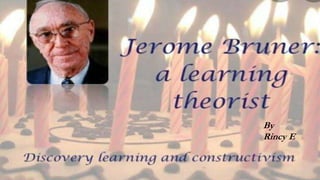
Bruner.pptx
- 1. By Rincy E
- 2. INTRODUCTION • Discovery of learning was introduced by Jerome. S. Bruner • This method is Inquiry based instruction • This popular theory encourage learners to build on past experience and knowledge • It helps to search new information and discover new things
- 3. Discovery of learning Bruner reasearch on the cognitive development of children (1966).He proposed three modes of representation
- 4. Discovery of learning 1.Enactive representation( action-based) 2.Iconic representation(image based) 3.Symbolic representation (language based)
- 5. Enactive(0-1year) • This appears first • It involves encoding action based on information and storing in our memory • The child represents past events through motor response • It is difficult to describe in iconic or symbolic • Through the movements child produce different sounds • If we shake a rattle baby must remember the action of shaking a rattle 1.Enactive(0-1year) • This appears first • It involves encoding action based information and storing it in our memory • The child represents past events through motor response • It is difficult to describe in iconc or symbolic • If we shake a rattle baby remember the action of shaking a rattle
- 6. 2.Iconic(1-6years) • This is were information is stored visually in the form of images • This consious, others say they don’t experience it • This may explain why, when we learn a new subject • It is often helpful to have diagrams or illustrations to accompany verba information 2.Iconic(1-6years) • Information is stored in the gorm of images(a mental picture in the minds eye • This is conscious, others say don’t experience it • This may explain why, when we are learning a new subject • It is helpful to have diagrams or illustrations to accompany verbal information
- 7. 3.Symbolic(7years onwards) • This develops last • In this stage information is stored in the form of a code or symbol, such as language • This is the most adaptable form of representation
- 8. • The actions and images have fixed relation which they represent • Dog is a symbolic representation of a single class • Symbols are flexible
- 9. • Symbols can be manipulated, ordered, classified...So the user can’t constrained by actions or images • In this stage knowledge is primarily stored as symbols, words or in other symbol systems • His constructive theory suggests it is more effective when faced with new things to follow progression from 1. Enactive to iconic 2. Iconic to symbolic
- 10. Importance of language • Language is an important for the increased ability to deal with abstract concepts • Bruner argues language can code stimuli and free an individual from the constraints • Language provides more complex yet flexible cognition • He sees infant as an intelligent and active problem solver from birth, with intellectual abilities is similar to the mature adult
- 11. Bruner’s model of concept learning • Bruner suggested a model on concept attainment and structure in teaching • He proposes economy in thinking & responding • It is categories according to their common attributes • An attribute is a property or characteristic of an object which differentiates it from the other
- 12. • Be categorised as objects having common Characteristics into on group • Teacher must identify the attributes • Bruner suggests that science should not be taught as a factorial subject but as a tool subject • bruner studied the strategies people use in acquiring concepts • for this he used a set of cards.some cards have borders others fo not
- 13. • Each card combines four attributes • Figure shape, figure number, figure colour & presence or absence of border • Each attribute has three values
- 15. Four Strategies in Concept Attainment 1. Simultaneous Scanning strategy 2. Successive Scanning strategy 3. Conservative Focussing strategy 4. Focus Gambling strategy
- 16. 1. Simultaneous scanning strategy Here the correct card is selected other cards rejected.This technique is not very efficient it places a great deal of strain in memory
- 17. 2.Successive scanning • Subject makes an overall estimate of each correct characteristics of each concept and test it one by one.This technique is inefficient
- 18. 3.Conservative focussing In this technique each attribute is tested by selecting a card that is different from a focus card only one attribute
- 19. 4.Focus Gambling Subject focuses on a correct card but varies more than one attribute at a time
- 20. Educationalimplications • According to Bruner (1961) the purpose of education not to impart knowledge • Education facilitate a child‘s thinking and problem solving skills • Education develops symbolic thinking in children • In 1960 Bruner’s text ’ The process of education ‘ was published
- 21. • The main premise of text was that students are active learners who can construct their own knowledge • Bruner opposed Piaget’s notion of readiness • Bruner argued schools are wasting time
- 22. • Bruner (1961) proposes that learners construct their on knowledge and do this by organizing and categorizing information using a coding system • The most effective way to develop coding system is to discover it rather than being told it by a teacher • The cocept of discovery of learning implies that students construct their own knowledge for themselves (constructive approach)
- 23. • The role of teacher is to facilitate the learning process • A good teacher will design lessons that helps the students to discover the relationship between bits of information • To do this a teacher must give information they need • Use of spiral curriculum can aid the process of discovery learning • The role of teacher should not be to teach information by rote learning
- 24. CONCLUSION Discovery of learning Encourage students to take Ownership of their own educational process .They learn to be curious and how to find answers to their own questions . They get excited when they find something new.